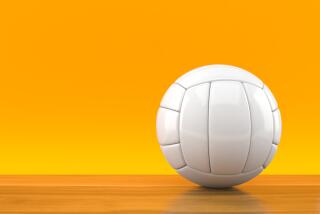Volleyball Appeals to Whole New Set : High schools: A sanctioned sport for only 3 1/2 years, boys’ volleyball is attracting a flock of participants.
SAN DIEGO — Last year, Jesse Taijeron thought of digs as a series of excavations or a comfortable place to live. To him, a spike was a metal prod or a small fish, and to serve normally involved a racquet or a tray of hors d’oeuvres.
Volleyball had become a boys’ sport in San Diego County high schools only 2 1/2 years before, and its terminology was foreign to Taijeron when he attended his first tryout at Southwest High in February, 1990.
Today, through hard work and tutoring from Coach Fred Sills and assistant coach Janet Cobbs, a member of the U.S. national women’s team, Taijeron is a key player for one of the best teams in the county.
On the other hand, Chris Steineke grew up with volleyball. He and his dad bumped, set and volleyed every chance they could get, growing up blocks from Mission Beach.
Steineke now lives in Encinitas and attends San Dieguito High. He, too, is one of the best players in the county.
In the 3 1/2 years that boys’ volleyball has been sanctioned by the San Diego Section of the CIF, San Dieguito has won three consecutive championships. A fourth could be in the making. The Mustangs defeated Southwest on Saturday to reclaim the No. 1 spot in the county coaches’ 3-A poll. Previously undefeated Southwest had been No. 1.
Because of players with backgrounds like Steineke’s, North County teams have dominated and continue to do so. But because of players such as Taijeron, teams in the South Bay and other parts of the county are catching up.
While increased interest in boys’ volleyball in the North County is entering its second decade, other parts of the county are only now catching on. But there is no denying, interest is on the rise.
These days, big crowds can be found at Montgomery as well as Mt. Carmel.
San Diego can give San Pasqual a match.
And Grossmont can be ranked ahead of San Marcos and Oceanside.
“I think it’s getting a lot more popular,” San Dieguito senior Teague Bode said, “and the competition is getting much better. We’re aren’t quite up to the talent of the good L.A. teams. But I think we’ve grown enough to be a factor there.”
Said Steineke, a senior, “It’s becoming a major sport. It’s grown immensely in just the past couple years.”
An informal survey taken by Fred Featherstone, the Grossmont College men’s coach and director of the Seaside Volleyball Club, indicates the same.
According to Featherstone, the average number of students who tried out for their high school teams this winter was 45.
“Some schools had as many as 80 come out for tryouts,” Featherstone said. “There were eight or nine that had 60 or more come out. That’s pretty impressive, I’d say, for our fourth year of high school volleyball.”
Most coaches around the county would agree.
Paula Zimmerman of San Pasqual and Kathy Platt of University City both said they had trouble filling their rosters when their programs began. Now they have to cut good players.
“It’s unbelievable to me how the skill level has come up in three years,” Platt said.
Said Zimmerman, “Every year, it’s broadening. Every year, there’s more and more players and more and more teams becoming factors. At San Pasqual, the second year after we had a team, our volleyball class in school tripled in size.”
And what seems remarkable to Platt and other coaches is that boys’ volleyball is played in the spring.
“Spring is a tough time because there’s so much going on,” Platt said. “Track, baseball, tennis, swimming, golf . . . the athletes are spread thin, but we’re still getting them.”
Opinions vary on volleyball’s growth, but they include the performance of the men’s team in the 1984 and ’88 Olympics, the fact that both the men’s and women’s national teams train in San Diego, and the growing popularity of beach volleyball.
“I think it’s a natural spinoff of all those factors and television,” Featherstone said. “Plus we have two quality publications now--Volleyball Magazine and Volleyball Monthly--and volley wear is really kicking into high gear. You’ve now got football, basketball and baseball people running around in volley wear.
“I think the public is realizing volleyball is a very dynamic sport.”
Girls’ volleyball has been a part of the San Diego Section for 18 years, and the CIF has been conducting state playoffs nearly as long.
Section Commissioner Kendall Webb said he doesn’t anticipate the CIF offering state playoffs for the boys in the near future--mostly because of money--but he has been pleasantly surprised with the growth of the sport in San Diego.
Students and coaches in the North County schools started the “groundswell” about 10 years ago with the emergence of club teams. A few years later, they formed a league, and by 1988, the rest of the county was ready to start.
San Dieguito defeated Poway in five games in the first championship match in 1988. Since then, there have been title matches for both the 2-A and 3-A divisions. San Dieguito won the 3-A in 1989 and ’90. La Jolla won the 2-A two years ago and San Pasqual last year.
With the Vikings winning in 1989, La Jolla’s Vicki Eveleth became the first coach to win both boys’ and girls’ championships.
San Dieguito Coach J.T. Ragan, who took over for Terry Calen this season, said the Mustangs’ titles may have come as a result of good timing. In ‘88, San Dieguito had player of the year Stace Lougeay, who now plays for UC Santa Barbara. The 3-A player of the year in ’89 and ’90 was San Dieguito’s Eric Sullivan, who is now at UCLA.
“It was just the right people at the right time,” Ragan said. “If they would have had a championship a few years before, Poway with Jud Buechler would have been the dominant team.”
Ragan added, “In football, the Green Bay Packers won in the beginning, and they haven’t been heard from in 20 years.”
Southwest’s Sills said the northern teams got the jump on the rest of the county, but the gap is closing.
“We were a number of years behind the North County because of the league play,” Sills said. “So it’s taken us three or four years to establish ourselves, and prove we could play at that level. We’re getting closer.”
Said Ignacio Soriano, a referee who has followed the development of the boys’ game, “Three years ago, people laughed at the teams down (in the South Bay). But now, Southwest, Bonita Vista, Mar Vista, Montgomery, those schools are right there. It’s really come a long way in a short time. I’m really impressed.”
This season, 58 San Diego County high schools offered boys’ volleyball. Of the ones that did not, only a handful are in the 2-A and 3-A classes. About 25% of the coaches are women.
Consider in the NCAA, there are only 58 men’s programs, compared to more than 700 women’s teams. The NAIA, which doesn’t offer men’s volleyball, has more than 500 women’s teams.
When St. Augustine, an all-boys school, went looking for a coach two years ago, the Saints chose a woman, Melissa Stokes.
Saints had won zero matches the previous year. Under Stokes, a former San Diego State standout, they finished second in league last year and are in first this year.
Said Stokes, who also coaches the girls’ team at San Pasqual, “When I first got (to St. Augustine), the administration said, ‘Good luck with these guys. You’ve got the non-athletes.’ I think we’re surprising a lot of people.”
Stokes and a number of others have proven that coaching can make a world of difference.
“I’ve always felt it takes three years to learn the sport,” Larry Cote, president of the San Diego Volleyball Officials Assn., said. “The first year, you’re just learning what it’s all about. The second year, you learn some technique and strategy. And the third year, you try to put it all together.
“The coaches make the biggest difference. If you’re a good coach, the kids will be there.”
The emergence of the high school game has also benefitted the local college teams.
The San Diego State men’s team, which won the only NCAA title in the history of the university and was ranked third for most of this season, could have as many as six San Diego County players next season.
Duncan McFarland, who played on the Aztec team that won the 1973 championship, started a men’s program at Palomar College four years ago. Two weeks ago, Palomar finished second in the state regional tournament using nothing but former San Diego high school players.
Digger Graybill, who has coached at UC San Diego for seven years, said he concluded his best recruiting season last year when he picked up Bruce Williams of San Pasqual and Tyson Kerr of Mira Mesa.
“From the perspective of a college coach, it’s added a number of players to the talent pool,” said Graybill, who added that the sport offers natural and beneficial exercises for other sports as well.
Said Zimmerman, “I would like to see more basketball coaches encourage it more because it’s a great cross-over sport.”
VOLLEYBALL POLL
3-A
Rank Team (League)
1. San Dieguito (Palomar)
2. Southwest (Metro)
3. Torrey Pines (Palomar)
4. Mt. Carmel (Palomar)
5. Poway (Palomar)
6. Mira Mesa (City Eastern)
7. Serra (City Eastern)
8. Bonita Vista (Metro)
9. Mar Vista (Metro)
10. Orange Glen (Palomar)
2-A
Rank Team (League)
1. USDHS (City Western)
2. San Pasqual (Avocado)
3. University City (City Western)
4. San Diego (City Central)
5. Grossmont (Grossmont 2-A)
6. La Jolla (City Western)
7. Francis Parker (Coastal)
8. San Marcos (Avocado)
9. St. Augustine (City Harbor)
10. Oceanside (Avocado)
Coaches poll conducted by Fred Sills, Southwest High School.
More to Read
Get our high school sports newsletter
Prep Rally is devoted to the SoCal high school sports experience, bringing you scores, stories and a behind-the-scenes look at what makes prep sports so popular.
You may occasionally receive promotional content from the Los Angeles Times.






